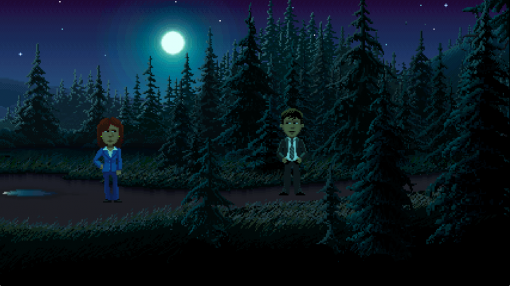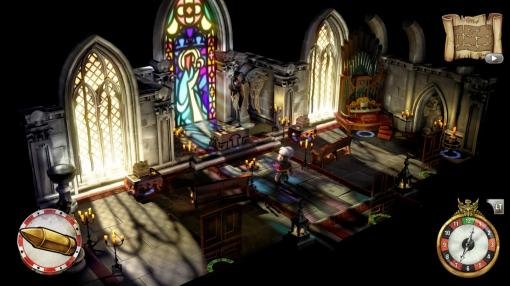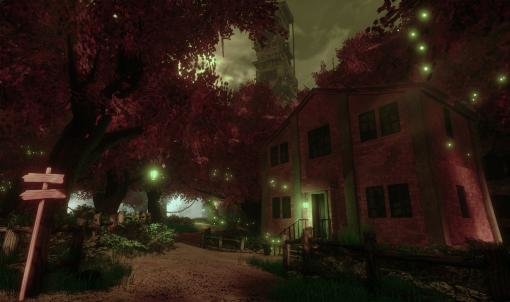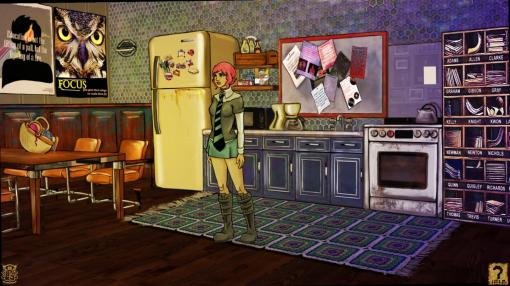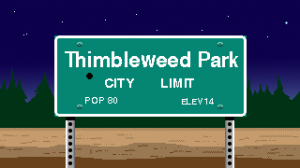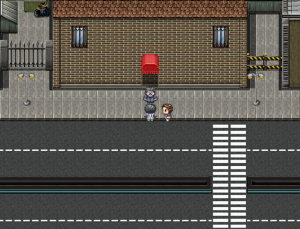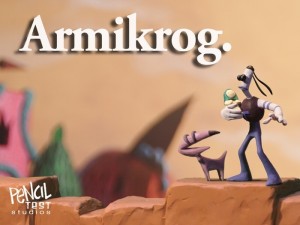Gamescom 2016 round-up: Part 2
Events Coverage
Reporting from E3, GDC, AdventureX, Gamescom and other gaming events around the world

With the issues created by over-crowding the last time I was at gamescom, and the increased security measures due to recent events, I dared at one point to hope this year would be a bit calmer. No dice. It was a bit easier to get from A to B after puzzling out the layout changes and press-only shortcuts, but the halls were no less packed and the lines no less long.
All the better for us though, as there was also no less material to cover. One developer told me he couldn't believe how people were still going on about the genre being in trouble with the amount of games coming out these days, and I'd have to agree. This was another good gamescom for adventure games. While my colleague Ingmar Böke was busy covering many other titles, I had my own full schedule of promising new games to see.
Thimbleweed Park
While I appreciate the classics as much as anyone, I must admit to a certain skepticism if not jadedness towards retro-style indie games. I mention this here because despite my reservations, Thimbleweed Park impressed me as a game I'm very happy I got to try for myself and not miss out on later. The developers – most notably Ron Gilbert and Gary Winnick – take the view that the key to a great retro experience is not just to create a game that could actually have been made back then, but rather one that conforms to a modern nostalgia-goggled notion of what could have been. To put it bluntly, the game “cheats”, and the results couldn't be better.
The color gradients in the backgrounds are old-school, but the palette itself is not, picking from full 24-bit color in whatever way best fits the situation. The character models are pixelated but significantly larger and more detailed than would have been feasible in the old days. There are also more little background animations than could have been done long ago, as well as dynamic lighting, parallax scrolling and advanced environmental manipulations that would have been unthinkable, such as rotating the whole background slightly when you move from one end to the other in a rickety caravan. Together with some great artwork, it all adds up to make a main resolution of 480×320 look absurdly good on a big modern screen. (As a final “cheat” of sorts, while the backgrounds stick to 480×320, some other things do not, most notably the character speech text.)
Of course, there's more to achieving a classic feel than graphics. But in the time I had with the demo I could find nothing whatsoever to worry about. The game started with playable FBI agent pair Ray and Reyes investigating a murder, with the task of photographing the crime scene serving as a tutorial in using the interface to exchange items, switch characters and interact with the environment. The interface is essentially Monkey Island 2's, plus the ability to switch between playable characters and surprisingly comfortable gamepad controls.
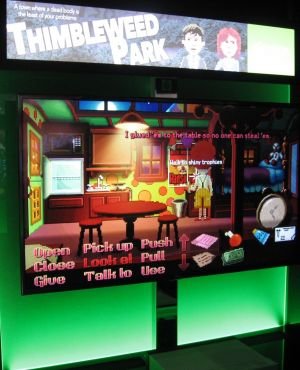 |
Thimbleweed Park's large wall display at gamescom |
With the photography done, asking around at the local bar quickly brought up Ransome the clown as a potential suspect, leading to a flashback segment played as him. The puzzles in this part as he gets ready for his show were as traditional as they come, and the difficulty would have been decent if I hadn't seen someone else play through the same section already. The music was also great here, even coming with local variations that transition into each other nicely enough that I had to ask if it used an iMuse-like system. (It turned out to be simple cross-fade, but it works great regardless.)
Ransome himself is a delightfully written, politically incorrect clown along the lines of The Simpsons' Krusty, with an act that turns out to consist of insulting the most vulnerable-looking members of the audience. He then makes the life-altering mistake of picking on local gypsy lady Madame Morena, whose all-too-real curses promptly cause him all kinds of subsequent misfortune. The flashback ended there, and the demo itself ended on a cliffhanger soon after involving agent Ray in a dark alley.
Trying to capture the feeling of a classic is always a challenge, but everything I've seen makes me feel that when it comes out in early 2017, Thimbleweed Park could be a piece of nostalgia-bait that actually delivers.
The Sexy Brutale
Cavalier Studios and Tequila Works' The Sexy Brutale was the game I knew the least about going in, and perhaps the most fascinatingly unusual one coming out. The title refers not to any particular character but to the building in which the story takes place, a casino built in a stately English manor and run by a mysterious Marquis. During an all-day masquerade ball there is a string of murders, leaving elderly priest Lafcadio Boone as one of the few survivors. Then time seems to reset and Boone is back in the morning, stuck in what looks to be an endless loop of horror.
While I always appreciate a nice, twisted time-travel plot, what I found more fascinating than the story itself is its effect on the gameplay. In this game you investigate murders not after the fact but while the preparations are still being made, leading to a kind of survival horror in reverse: skulking around peering through doorways and hiding in closets, you must stalk the (suspected) murderers to figure out their activity schedule. Then when you feel you've learned enough, it's time to make your plans and strike.
You do still have to be subtle about your interventions. Boone is not exactly a combatant, and even if he were, there is a strange power to the masks being worn that forces you out if you so much as occupy the same room as another character (while also making that person forget you were there). This is where more traditional adventure gameplay comes in. There are items lying around that can be picked up and objects that can be interacted with; manipulate the circumstances the right way without being seen and you can throw a wrench into the murder plots. In the tutorial level I saw, this was as simple as switching out a bullet for a blank in the murder weapon, but the difficulty will ramp up with far more convoluted schemes as you advance.
All of this plays out in an isometric perspective, using slightly-cartoonish graphics with some great lighting effects. Besides working well visually, the perspective gives you a good overview of each room and lets you move from room to room efficiently when you're after someone. Other conveniences include a zoomed-out view that lets you track people in nearby rooms by their sound, and a reconstruction screen that automatically records what you have noticed of each character's whereabouts at different points in time.
When you successfully prevent a murder, the victim has a moment of clarity and takes their mask off. This lets you talk to them to get a bit closer to unraveling the larger mysteries and receive something for your trouble, like a special ability or an item that stays with you when time resets. (Ordinary inventory items just go back to where you found them.) These in turn help you resolve other murders until you've fixed all of them, at which point the game will head towards the finale.
The original gameplay angle may make The Sexy Brutale feel like a bit of an odd duck genre-wise, but to me it's all the more reason to pay close attention when it arrives in the first quarter of 2017.
Blackwood Crossing
“Dream-like” is the best way to describe what I saw of PaperSeven's Blackwood Crossing, a first-person game exploring the relationship between orphaned siblings Scarlett and Finn. Skipping past two prologues that should be more grounded in reality, the demo dropped me into what seemed like a dream sequence of sorts right at the start. Scarlett was chasing Finn through a train while passing various side characters that have played some role in their lives, including their dead parents. To hammer down the surrealness, these characters had their heads replaced with papercraft masks and were mostly frozen in time. Disjointed dialog lines and brief puzzles revealed glimpses of their significance and what it all meant, but for the most part things were left to the imagination.
If there was any doubt about how fantastical this section was, the transition into the next got rid of that promptly. What turned out to be the last train wagon was filled with plants and grass surrounding a tree trunk going up through the ceiling, and trying to get to the area beyond instead led to a greenhouse. Here the game started to come into its own graphics-wise, leaving behind the muted palette and understandably repetitive interiors of the train to burst alive with vibrant colors and imaginative environments, with a treehouse setting containing a very nicely improvised planetarium that PaperSeven co-founder Alice Guy described as one of her favorite places in the game.
As they met up in the treehouse, Scarlett relived part of her past with Finn, helping him make papercraft butterflies as they discussed life. Things got more cohesive in this last scene of the demo than in the train, but only to a point. Like in a dream, the story in Blackwood Crossing seems to be something to be explored and put together, not something that's handed to you straightforwardly. If you don't mind a little narrative ambiguity, this game looks set to be a very nice journey when it arrives in early 2017.
Empathy
I wasn't too sure what to expect from the first-person, exploration-heavy 3D adventure game Empathy at the Iceberg Interactive booth, and now that I do I can't tell you any of the spoilerific things I've heard about the story. Broadly, though, it explores themes of social struggle and collapse along lines of politics, class and ideology.
Getting back to the ground a bit, the game starts in a laboratory room setting as you are trying to get some machines running properly under the guidance of the narrator. The latter starts out talking up the importance of what you're about to do, but then stays oddly calm and unconcerned when you mess things up and cause one of the incidents underlying the plot. The story's main conceit is that a number of failed grandiose experiments have affected people's emotional states, which has caused a slow collapse of society through many kinds of internal strife. After the prologue, you explore society in its largely ruined state, not meeting any other people directly but seeing many things left behind.
There is also a consistently surreal element, with level design that doesn’t cross over into things that are actually impossible but does seek out the line. For instance, the first large area to explore is like a floating island, except that it is actually held up by an enormous statue. Further surrealness comes from “glitchy” visual effects when finding items that don't seem to belong or getting badly hurt.
Gameplay-wise, Empathy is first and foremost an exploration game, focused on collecting so-called memory items. These items can be found lying around the places you explore, looking like a ghostly outline at first, until you solve a brief 'synchronization' minigame to align and bring them into the world properly. Doing this reveals a memory of the person each item belongs to, usually raising questions that will only be answered when you've found a whole set and the memories get put together in a scene you then experience first-hand. This in turn may give you hints on where to go next or even create changes in the world, letting you visit previously inaccessible areas.
To aid you along if you get too stuck, you pick up a handy radar early in the game that helps you find some items needed to progress. However, beyond the story items the developers have added many more you'll have to look for the hard way, feeling that further exploration should always be rewarded. Beyond exploration and memory-reconstruction, there will also be other gameplay in the form of actual items to pick up and use, logic/math puzzles, environment obstacles and occasional environmental hazards to avoid.
The graphics are set to be polished more before the game releases, and I must say this seemed like a good idea for some parts I observed. With a little more fine-tuning, however, there should be a number of captivating things to explore when Empathy comes out early next year.
The Lion's Song: Episode 2 – Anthology
You may remember The Lion's Song from the free first episode, where up-and-coming composer Wilma retreats to a mountain cabin to get some calm and inspiration to compose the titular musical piece.
Leaving Wilma alone for a while, the second (and no longer free) episode involves the creative struggles of a new character, budding painter Franz Markert. The sepia-tinted art style is essentially the same as before, but walking animations and slightly smaller characters let you pace around your studio and visit salons in early 20th century Vienna to talk people into letting you do their portraits. This time, though, the gameplay is focused less on finding inspiring subject matter than the first episode and more on the execution.
 |
The Lion's Song booth at gamescom |
This is handled through a “personality layers” game mechanic: while painting a client, you discuss their life and background with them in a dialog puzzle of sorts. Depending on the way the conversation goes, different aspects of the client's personality manifest, each visualized with a particular posture. Bring out the same layer enough times and you “unlock” it, adding it to the painting. For the best result, you will want to unlock all of the client's layers, or as many as you can at least. I personally couldn't get a perfect result for either of the two clients I did in the demo, so there may be some replay value for perfectionists. If you can't get them all you may also want to be picky in which layer you focus on, as your clients may appreciate the resulting portrait more if you catch their good side.
These personality layers also play an important part in the plot, as Franz can almost literally see these layers, appearing in his mind's eye like some sort of impressionistic art. He cannot, however, look into his own personality in the mirror. This and some less comfortable symptoms will eventually cause him to discuss his condition with famed psychiatrist Sigmund Freud in an end sequence of mutual psychoanalysis.
There will also be small connections between this episode and the previous one. In a unique twist, these connections work both ways: if you play the second episode before the first, your successes can help inspire Wilma, who has some of Franz's sketches lying around in the mountain cabin. If you are wondering how any of the second episode's plot ties into the titular Lion's Song, that should be revealed in the series finale, which will bring together the characters and storylines of the first three parts. There is no firm release date yet, but if earlier estimates hold, Anthology should come out sometime this year.
The St. Christopher's School Lockdown
Due to some logistical issues in meeting with Classroom Graffiti Productions, I wasn't able to spend much time looking at The St. Christopher's School Lockdown, the indie adventure set in a prestigious British private school that’s been seized by its student body in a protest demonstration. Still, going over a couple of rooms in the demo with Roger Benoit showed me some promising things. The first to stand out was the large amount of writing going into even those few screens. One typical example was in a scene where you have to find a specific staff member's mailbox: where other games might give generic lines for a few wrong choices, in this case there were distinct readable contents in each of the 60-ish available boxes. In the nearby kitchen, you can read various staff members' favorite soup recipes and assorted notes, or interact with pointless things right down to the fridge magnets.
This philosophy extends to the rest of the game, where every character will have their own backstory, even those who only have a couple of lines throughout the game. A school yearbook will collect everything you know about them for you to look through at your leisure. More writing also means more choice, and every major puzzle will have multiple possible solutions to it.
What stood out to me more than that was a game-mechanics thing. Kayleigh, the main character for the first episode, suffers from a form of bipolar disorder, and this has unique gameplay consequences. As dramatic things happen in the story, her mental state changes towards either the manic side or the overly mellowed-out side. When you swing too far in either direction, this in turn affects the visuals, the interface and even the options you have in your conversations and actions. You can regain your composure through a special minigame, or you can try to roll with it and explore the differences it makes (though the manic side creates an increasing amount of cursor jitter, so you will eventually be forced to take a timeout and get a hold of yourself).
The distinctive graphic novel style looks quite nice, though it takes some getting used to and some of the animations feel like they could have been a bit smoother. The game is still a work in progress, of course, but you can see it in its current state in the public demo now available for Windows, Mac, and Linux.
The remaining details aren't completely worked out yet, but each of the first six episodes has a different playable character and its own special game mechanics. It’s been a long wait for the first, but the series debut is getting close now, with a target release of March 17 of next year.


